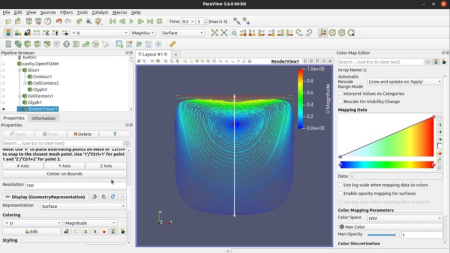
h264, yuv420p, 1018x572 |ENGLISH, aac, 48000 Hz, 2 channels | 1h 45 mn | 1 GB
Created by: Hasbullah Padzillah
Do you want to run a Computational Fluid Dynamics simulation without having to purchase expensive software licenses?
Mastering OpenFOAM to conduct your Computational Fluid Dynamics simulations without expensive software licenses What you'll learn
Comfortably use free OpenFoam software to solve fluid dynamics problems
Refresher on background of Computational Fluid Dynamics
Step-by-step customisation of geometry and meshing prior to the simulation
Easily create custom script for fast and efficient post-processing
Requirements
No prerequisites are necessary
You should be excited to take advantage of a free CFD software
Ready to forget scattered information about OpenFOAM all over the internet which is not necessarily all true, this is the only course that you need to learn OpenFOAM
Description
At this point, more than 100 000 students and working professionals are taking advantage of OpenFoam all around the world. Gone are the days that OpenFoam is hard to learn and too involved with programming.
Whether you are a student or a working professionals in fluid dynamics area, conducting a Computational Fluid Dynamics Simulation using a free software such as OpenFOAM will give you the edge over your colleagues and competitors who are using the expensive commercial software.
OpenFOAM is the most comprehensive open source CFD software in the market and is being used widely in both academia and industries.
This course will take you through the step-by-step process of how to install OpenFOAM in your PC and will also introduce you the background theory on Computational Fluid Dynamics.
We will then work on our very first simulation which uses incompressible flow as the working fluid. I will explain to you how the geometry is created, and subsequently how to mesh them according you your requirement.
We will then run the simulation and view the results using ParaView, which comes preinstalled with openFOAM.
From Bner to Advanced
You will see that wherever you are in your CFD journey, this course is definitely for you. For the complete bner, I've included the theoretical CFD background to get you equipped with the knowledge necessary for running your first OpenFOAM simulation.
At advanced level, I'll show you how to use tools like SnappyHexMesh to literally mesh any geometry that you would like using OpenFOAM. This course also shows you steps to validate your simulations against expental data. Perhaps, most importantly, you will learn how to efficiently extract data from the results using your very own post-processing script.
On Going Content
To maximize the value you get for your money, new contents are uploaded every week. You will be notified once new content is uploaded.
What you will learn
OpenFOAM installation
Background of CFD
Incompressible flow simulation
Manipulation of grid mesh
How to test and validate your results
Meshing and simulations of complex geometries
Building Post-processing script
Who am I
Hi, I'm Hasbullah (Has). I have obtained a PhD in Fluid Dynamics and Turbomachinery area from Imperial College London.
As a researcher in Fluid Dynamics area, I have been perfog Computational Fluid Dynamics simulations for over 10 years. I have worked on many CFD simulations, which includes both for acad publications and also industry solutions.
Numerical simulation is a great tool to enable flow visualisation around an object in order to understand how it works, and also to improve the design with short turnaround .
I am also professionally teaching Fluid Dynamics in a university for more than 5 years.
This will allow me to effectively introduce underlying theories while perfog tasks in this course. This enables you to gain greater understanding about the simulations, which in turn makes it easy for you to analyse and make sense of the results during post-processing.
I am excited to have you as a student, and I hope that the materials provided in this course would serve you long and well in your career.
Who this course is for:
Bner to advanced Computational Fluid Dynamics practitioners
Undergraduate and Postgraduate students in fluid dynamics areas
Acads and eeers that are keen to explore open source software to solve fluid dynamics problems
DOWNLOAD
uploadgig
rapidgator
nitroflare

